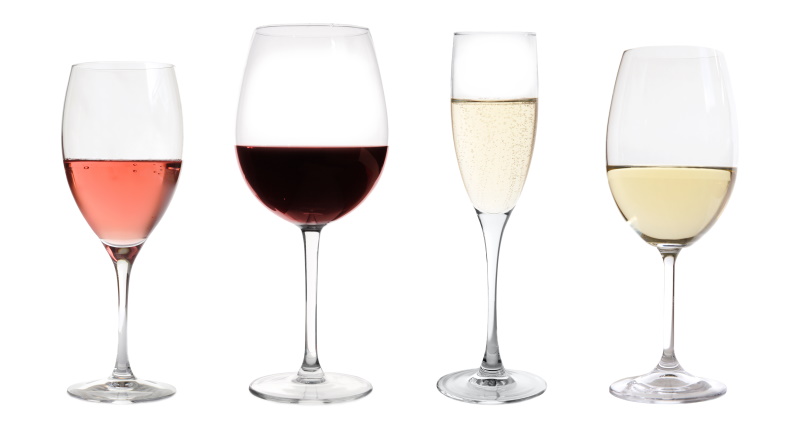
For those who invest in fine wine, selecting the appropriate glass for each pour is an important part of an optimal drinking experience. Wine glasses are carefully designed to bring out the essential flavors of different types or varietals of wine and give you the best possible experience. Follow this guide to ensure that you choose the best glass to pair with your bottle of wine, making each sip as enjoyable as possible.
Anatomy of a Wine Glass
When selecting a wine glass, there are three main components to consider: the base, the stem, and the bowl.
The base, or foot, of the wine glass is the part of a stemmed wine glass that comes in contact with the table. It maintains the stability of the glass. Stemless wine glasses will not have a base.
The stem connects the base of the wine glass to the bowl. It’s also missing in stemless glasses, but it serves an important function: by holding the glass by the stem rather than by the bowl, you avoid warming up the wine with your hands. This is a key consideration for wines best served chilled.
The bowl of the glass is what varies the most as you select the appropriate glass shape for your bottle of wine. The depth and breadth of the bowl — the space in the glass that holds the wine — will affect how much of the wine is exposed to the air and how its aromas are released as a result. Sommeliers recommend filling each type of wine glass to the widest part of the bowl for the best pour.
Although the different shapes and styles of wine glass will vary based on wine varietal and personal aesthetic, these are the essential factors to consider as you find just the right glass for your wine.
Glasses for Reds
In general, red wine glasses tend to have bigger bowls than glasses for whites. This is because reds need more space to breathe and “open,” releasing more of their flavors and aromas as they come in contact with the air. However, just as there is a variety of flavor and texture within the category of reds, there’s also a range of red glasses that maximize those flavors.
Bold Reds
For bold reds like Bordeaux, Cabernet, and Merlot, select a tall glass with a wide base and medium stem. The bowl should taper at the opening. This allows more oxygen to come in contact with the wine, bringing out the fruit flavors and smoothing out the taste.
Medium to Full-Bodied Reds
For wines like Syrah, Shiraz, or Malbec, look for a shorter glass with a smaller bowl that is slightly more tapered at the opening. This allows the wine to hit your palate more gradually, softening harsh flavors and strong spices.
Fruit-Forward Reds
For intense, fruit-forward reds like Burgundy and Pinot Noir, select a shorter stem and wide bowl. Allowing a greater surface area of oxygen to come into contact with the wine helps to develop the flavors in these wines and deliver them to your palate.
Glasses for Whites
White wine glasses tend to be taller with narrower bowls, which directs the wines’ lighter aromas upward to your nose. There are generally two distinct shapes of white wine glasses, and the selection of each depends on the amount of body in your white. You’ll want to be careful to select stemmed wine glasses for whites, since holding a glass by the bowl rather than the stem will raise the temperature of a chilled wine.
Light to Medium-Bodied Whites
For light to medium-bodied white wines like Sauvignon Blanc or Riesling, choose a glass with a mid-long stem and narrow bowl that tapers in slightly. The bowl should also be thinner compared to red wine glasses. This size and shape makes it easier to access the aromas in the wine while also minimizing the amount of oxygen in the glass.
Full-Bodied Whites
Full-bodied whites like Chardonnay do best in a glass with a large bowl. The best glass for these wines looks like a Burgundy/Pinot Noir glass but is slightly smaller and features a shorter stem. As with a full-bodied red, the large bowl allows for a big surface area that allows oxygen to get into the glass and open up the flavors.
Dessert and Specialty Wine Glasses
Not every wine falls into the red or white category. What about sparkling and dessert wines? They each need their own special glass to optimize flavors and aromas.
Dessert Wines
Dessert and fortified wines have much more concentrated, intense flavor profiles, so they need their own glasses to make their tastes pop. Look for a short glass with a narrow bowl, designed to deliver the wine slowly down the center of your mouth toward the back of your tongue, where the sweetness of the wine can be detected.
Sparkling Wines
Sparkling wines and champagnes do best in tall, narrow glasses that help retain the carbonation of the wine and deliver those bubbles directly to your tongue. Although vintage-style champagne glasses with wide bowls have recently come back into fashion, they cause the wine to go flat and warm to room temperature much more quickly than a fluted glass, which preserves both the carbonation and the chill of the wine. Be sure to choose glasses with a wide base that balance out the tall shape of the glass and stabilize it.
Choosing the Right Wine for Your Glass
Once you’ve found just the right set of glasses to enjoy your wines, replenish your stores at JJ Buckley Fine Wines, which offers a wide range of exquisite wines. For more personalized recommendations, JJ Buckley’s consultancy services can advise you on just the right bottle for any occasion. Their knowledgeable wine specialists provide honest, impartial advice without pretension. JJ Buckley’s services can help you build and expand your wine collection as well as tailor recommendations to your individual preferences.